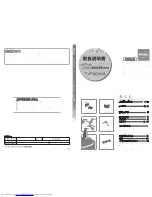
38
ATTENTION!
Machine maintenance, checking and overhaul op-
erations must only be carried out by a specialised
Technician or the After-Sales Service, provided
with adequate personal protection equipment
(safety shoes and gloves), tools and ancillary
means.
ATTENTION!
Work on the electrical equipment must only be
carried out by a specialised electrician or the
After-Sales Service.
D.1.4 DISASSEMBLY
If the appliance has to be disassembled and then reassembled,
make sure the various parts are assembled in the correct order
(if necessary mark them during disassembly).
Before disassembling the machine, make sure to carefully check
its physical condition, and in particular any parts of the structure
that can give or break. Before starting disassembly:
- remove all the pieces (if present) in the machine;
- disconnect the power supply;
- enclose the work area;
- place a sign on the Main Electrical Panel indicating that the
machine is undergoing maintenance and not to carry out
manoeuvres;
- carry out the disassembly operations.
ATTENTION!
All scrapping operations must occur with the ma-
chine stopped and cold and the electrical power
supply disconnected.
ATTENTION!
Work on the electrical equipment must only be car-
ried out by a qualified electrician, with the power
supply disconnected.
ATTENTION!
To carry out these operations, appropriate PPE
must be used.
ATTENTION!
During disassembly and handling of the various
parts, the minimum height from the floor must be
maintained.
D.1.5 DECOMMISSIONING
If the machine cannot be repaired, carry out the decommissioning
operations, signalling the failure with a suitable sign, and request
assistance of the manufacturer’s after-sales service.
D.2 MACHINE DISPOSAL
ATTENTION!
DISMANTLING OPERATIONS MUST BE CARRIED
OUT BY QUALIFIED PERSONNEL.
ATTENTION!
WORK ON THE ELECTRICAL EQUIPMENT MUST
ONLY BE CARRIED OUT BY A QUALIFIED ELEC-
TRICIAN, WITH THE POWER SUPPLY DISCON-
NECTED.
D.2.1 WASTE STORAGE
At the end of the product’s life-cycle, make sure it is not dispersed
in the environment. The doors must be removed before scrapping
the appliance.
Special waste materials can be stored temporarily while awaiting
treatment for disposal and/or permanent storage. In any case,
the current environmental protection laws in the country of use
must be observed.
D.2.2 PROCEDURE REGARDING APPLIANCE DISMANTLING
MACRO OPERATIONS
Before disposing of the machine, make sure to carefully check
its physical condition, and in particular any parts of the structure
that can give or break during scrapping. The machine’s parts
must be disposed of in a differentiated way, according to their
different characteristics (e.g. metals, oils, greases, plastic, rubber,
etc.). Different regulations are in force in the various countries,
therefore comply with the provisions of the laws and competent
bodies in the country where scrapping takes place.
In general, the appliance must be taken to a specialised
collection/scrapping centre. Dismantle the appliance, grouping
the components according to their chemical characteristics,
remembering that the compressor contains lubricant oil and
refrigerant fluid which can be recycled, and that the refrigerator
components are special waste assimilable with urban waste.
The symbol
placed on the product indicates that it should
not
be considered as domestic waste, but must be correctly
disposed of in order to prevent any negative consequences for
the environment and the health of people.
For further information on the recycling of this product, contact
the local dealer or agent, the after-sales assistance service or
the local body responsible for waste disposal.
ATTENTION!
Make the appliance unusable by removing the pow-
er cable and any compartment closing devices,
to prevent the possibility of someone becoming
trapped inside.
ATTENTION!
When scrapping the machine, the “CE” marking,
this manual and other documents concerning the
machine must be destroyed.
D.3 ENCLOSED DOCUMENTS
• Set of test and inspection documents
• Wiring diagram
• Installation diagram






























